-
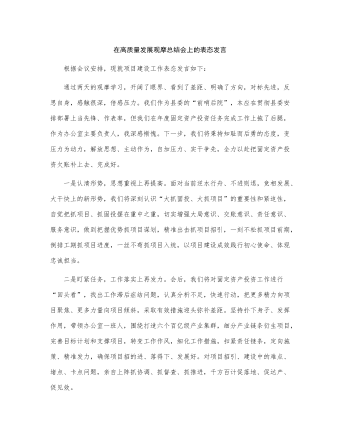
在高质量发展观摩总结会上的表态发言
对项目招引、建设中的难点、堵点、卡点问题,亲自上阵抓协调、抓督查、抓推进,千方百计促落地、促达产、促见效。三是学习借鉴,统筹谋划上再推进。坚持以提升本领为关键,狠抓项目招引建设业务培训和实践锻炼,着力从一切不合时宜的思维定式、固有模式、路径依赖中解放出来,以业务能力提升促进工作成效提升。同时,认真学习其他部门抓项目招引、建设的好经验、好做法,发扬“比学赶超”拼搏精神,在站位上再提升、思路上再调整、方法上再优化、措施上再加力,切实以拼的意识、抢的状态、实的作风推动办公室固定资产投资工作提质增效。我们将认真贯彻落实县委工作部署和此次会议精神,真正把项目建设抓在手里,把责任扛在肩上,全心全意谋划,不遗余力推动,坚决完成固定资产投资任务,向县委交上一份满意答卷。
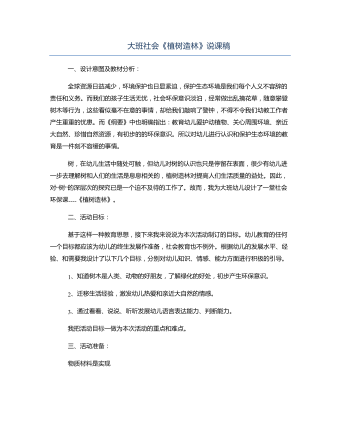
大班社会《植树造林》说课稿
全球资源日益减少,环境保护也日显紧迫,保护生态环境是我们每个人义不容辞的责任和义务。而我们的孩子生活无忧,社会环保意识淡泊,经常做出乱摘花草,随意攀登树木等行为,这些看似毫不在意的事情,却给我们敲响了警钟,不得不令我们幼教工作者产生重重的忧患。而《纲要》中也明确指出:教育幼儿爱护动植物、关心周围环境、亲近大自然、珍惜自然资源,有初步的的环保意识。所以对幼儿进行认识和保护生态环境的教育是一件刻不容缓的事情。树,在幼儿生活中随处可触,但幼儿对树的认识也只是停留在表面,很少有幼儿进一步去理解树和人们的生活是息息相关的,植树造林对提高人们生活质量的益处。因此,对“树”的深层次的探究已是一个迫不及待的工作了。故而,我为大班幼儿设计了一堂社会环保课----《植树造林》。
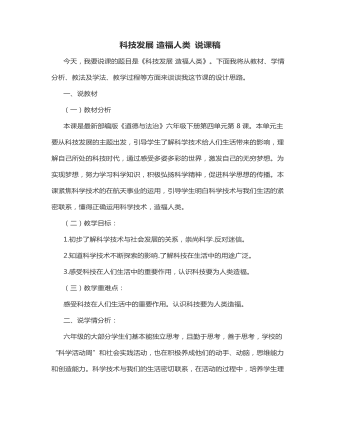
科技发展造福人类 说课稿
今天,我要说课的题目是《科技发展 造福人类》。下面我将从教材、学情分析、教法及学法、教学过程等方面来谈谈我这节课的设计思路。一、说教材(一)教材分析本课是最新部编版《道德与法治》六年级下册第四单元第8课。本单元主要从科技发展的主题出发,引导学生了解科学技术给人们生活带来的影响,理解自己所处的科技时代,通过感受多姿多彩的世界,激发自己的无穷梦想。为实现梦想,努力学习科学知识,积极弘扬科学精神,促进科学思想的传播。本课紧焦科学技术的在航天事业的运用,引导学生明白科学技术与我们生活的紧密联系,懂得正确运用科学技术,造福人类。(二)教学目标:1.初步了解科学技术与社会发展的关系,崇尚科学.反对迷信。2.知道科学技术不断探索的影响.了解科技在生活中的用途广泛。3.感受科技在人们生活中的重要作用,认识科技要为人类造福。(三)教学重难点:感受科技在人们生活中的重要作用。认识科技要为人类造福。

大班科学《人造彩虹》说课稿
二、活动目标根据以上的分析和思考及大班幼儿的年龄特点,我从认知、情感、能力三方面来制定这次活动的目标。1、在观察、探索中了解彩虹现象的由来。2、尝试用多种方法制造“彩虹”,产生对自然界奇妙现象的兴趣。3、愿意与同伴交流,分享探索的过程。4、根据目标:我的活动重点是在观察、探索中了解彩虹现象的由来。活动难点是尝试用多种方法制造“彩虹”,产生对自然界奇妙现象的兴趣。三、活动准备为了使活动呈现出趣味性、综合性,寓教育于生活情境中、游戏中,我做了以下的准备:1、选择一个明媚的日子。2、课件一份,镜子人手一份,盆中装满水,圆珠笔,色拉油,白纸,三棱镜,放大镜,泡泡。四、活动过程根据幼儿的年龄特点,我设计了以下五个环节:引起幼儿的兴趣——迁移经验,了解彩虹的由来——学习动手制造“彩虹”——交流实验结果——延伸活动。我是让孩子们在操作探索中亲身体验,了解彩虹现象的由来,克服重点和难点。具体过程如下:(一)引起幼儿的兴趣。我通过以下三个小环节来实施:1、幼儿自由玩镜子。幼儿在玩中和同伴说说从水中的镜子中找到了什么?2、引导幼儿在水中把镜子对着太阳照射。3、说说自己的发现。数一数有几种颜色?它们是怎么排列的?我开始的直接提问是让孩子们拿着镜子在水中自由玩耍,讨论自己的发现,幼儿讨论的问题肯定不充分,之后我用语言提示他们“在水中把镜子对着太阳照一照”,这样有目的的引导,让他们自己去发现“彩虹”这一奇妙的自然现象:镜子中能反射出七彩的颜色。(二)了解彩虹的由来。这一环节我出示雨中、雨后的课件制作,让幼儿观看课件彩虹是怎么产生的,最后得出结论:彩虹是夏天雷雨过后出现的自然现象,是天空中飘着许多的小水滴经过阳光照射后形成的,彩虹是红、橙、黄、绿、青、蓝、紫这样排列的。屏幕上雨后的课件鲜艳的颜色刺激着小朋友的感官,使他们的手、脑、眼、嘴并用,每个孩子都能全身心的融入学习中。(三)学习动手制造“彩虹”。前一环节的介绍,幼儿对“彩虹”的由来产生了浓厚的兴趣,教师可以这样引导“这么漂亮的彩虹一会就没有了,怎么办呢?”我直接把问题抛给幼儿,让他们想办法解决,孩子们肯定会说:“我们可以自己做一条‘彩虹’呀?那怎么制造‘彩虹’呢?”带着这个问题,让孩子们自己寻找材料,如:泡泡、放大镜、三棱镜、圆珠笔、白纸……幼儿自由地尝试用多种方法制造“彩虹”,教师用问题设置的方法边观察幼儿操作,边及时地提出问题进行引导,幼儿在尝试操作过程中交流、合作。本环节是运用了尝试法和操作法,也是活动的难点之处。

医院改造工作总结
医院是一个特殊的场所,承担着对里的罪犯进行医疗保健和心理疏导的任务。在改造工作中,医院需要从多个方面进行努力,以确保犯人得到适当的医疗和心理健康支持。本文将就医院改造工作进行总结,并提出一些建议。首先,医院需要建立一支高素质的医疗团队。这个团队由医生、护士、心理医生等专业人员组成,他们应具备专业的医疗技术和丰富的实践经验。同时,他们也需要具备对罪犯特殊需求的理解和关爱之心,以便更好地进行治疗和疏导工作。其次,医院应建立科学合理的医疗管理制度。包括定期体检、医疗记录的完善、药品管理的规范等方面。医院应积极引入信息技术,建立电子病历系统,方便医疗团队进行多方位、全周期的管理和诊疗工作。此外,医疗器械及设备的现代化也是保障医疗质量的重要保证。另外,医院在心理疏导方面也应加大力度。罪犯在里往往面临着压抑、孤独和挫折等负面情绪,容易出现焦虑、抑郁等心理问题。因此,心理医生应与罪犯建立起信任和良好的沟通关系,通过心理咨询、心理治疗等方式,帮助罪犯调整心态、缓解压力。
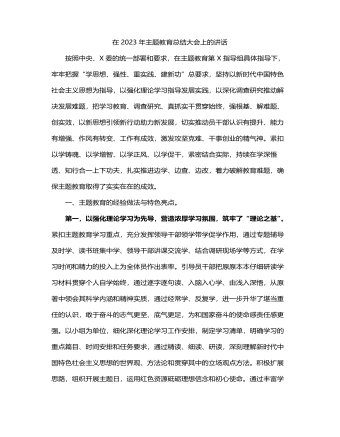
在2023年主题教育总结大会上的讲话
第三,进一步抓好问题整改落实,将主题教育问题整改与推进改革发展有机结合起来,严格对标对表,坚持统筹兼顾、标本兼治,确保整改落实全面到位,同时扎实做好第二批主题教育的谋划准备工作,确保整个主题教育上下联动、有机衔接。深刻认识检视整改是确保主题教育取得实效的关键一环,切实增强做好检视整改工作的政治自觉,坚持边学习、边对照、边检视、边整改,在抓好问题整改上下真功夫、下狠功夫,做到问题不解决不松手、整改不到位不罢休。对检视梳理的问题必须主动认领、自觉对号入座、深刻剖析根源,搞清楚是思想问题还是能力问题,是方法问题还是作风问题,是长期存在的顽瘴痼疾,还是最近才出现的急难杂症,做到真认账、真反思、真整改。从政治上认识、推进和检验整改工作,把人民群众满意不满意作为根本检验标准,增强“等不起、慢不得、坐不住”的紧迫感,把按时完成检视整改作为军令来执行,持续盯住问题不放、严格落实整改措施,确保事事有着落、件件有结果。把制度建设贯穿检视整改全过程,强化制度刚性约束,把整治成效转变为治堵效果,做到既谋当下、又管长远。
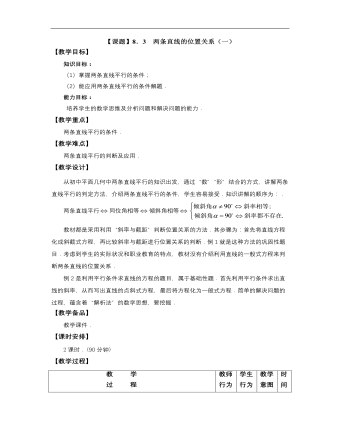
高教版中职数学基础模块下册:8.3《两条直线的位置关系》优秀教案设计
教 学 过 程教师 行为学生 行为教学 意图 *揭示课题 8.3 两条直线的位置关系(一) *创设情境 兴趣导入 【知识回顾】 我们知道,平面内两条直线的位置关系有三种:平行、相交、重合.并且知道,两条直线都与第三条直线相交时,“同位角相等”是“这两条直线平行”的充要条件. 【问题】 两条直线平行,它们的斜率之间存在什么联系呢? 介绍 质疑 引导 分析 了解 思考 启发 学生思考*动脑思考 探索新知 【新知识】 当两条直线、的斜率都存在且都不为0时(如图8-11(1)),如果直线平行于直线,那么这两条直线与x轴相交的同位角相等,即直线的倾角相等,故两条直线的斜率相等;反过来,如果直线的斜率相等,那么这两条直线的倾角相等,即两条直线与x轴相交的同位角相等,故两直线平行. 当直线、的斜率都是0时(如图8-11(2)),两条直线都与x轴平行,所以//. 当两条直线、的斜率都不存在时(如图8-11(3)),直线与直线都与x轴垂直,所以直线// 直线. 显然,当直线、的斜率都存在但不相等或一条直线的斜率存在而另一条直线的斜率不存在时,两条直线相交. 由上面的讨论知,当直线、的斜率都存在时,设,,则 两个方程的系数关系两条直线的位置关系相交平行重合 当两条直线的斜率都存在时,就可以利用两条直线的斜率及直线在y轴上的截距,来判断两直线的位置关系. 判断两条直线平行的一般步骤是: (1) 判断两条直线的斜率是否存在,若都不存在,则平行;若只有一个不存在,则相交. (2) 若两条直线的斜率都存在,将它们都化成斜截式方程,若斜率不相等,则相交; (3) 若斜率相等,比较两条直线的纵截距,相等则重合,不相等则平行. 讲解 说明 引领 分析 仔细 分析 讲解 关键 词语 思考 理解 思考 理解 带领 学生 分析 引导 式启 发学 生得 出结 果

高教版中职数学基础模块下册:10.3《总体、样本与抽样方法》优秀教案设计
教 学 过 程教师 行为学生 行为教学 意图时间 *揭示课题 10.3总体、样本与抽样方法(二) *创设情境 兴趣导入 【问题】 用样本估计总体时,样本抽取得是否恰当,直接关系到总体特性估计的准确程度.那么,应该如何抽取样本呢? 介绍 质疑 了解 思考 启发 学生思考 0 5*动脑思考 探索新知 【新知识】 下面介绍几种常用的抽样方法. 1.简单随机抽样 从一批苹果中选取10个,每个苹果被选中的可能性一般是不相等的,放在上面的苹果更容易被选中.实际过程又不允许将整箱苹果倒出来,搅拌均匀.因此,10个苹果做样本的代表意义就会打折扣. 我们采用抽签的方法,将苹果按照某种顺序(比如箱、层、行、列顺序)编号,写在小纸片上.将小纸片揉成小团,放到一个不透明的袋子中,充分搅拌后,再从中逐个抽出10个小纸团.最后根据编号找到苹果. 这种抽样叫做简单随机抽样. 简单随机抽样必须保证总体的每个个体被抽到的机会是相同的.也就是说,简单随机抽样是等概率抽样. 抽签法(俗称抓阄法)是最常用的简单随机抽样方法.其主要步骤为 (1)编号做签:将总体中的N个个体编上号,并把号码写到签上; (2)抽签得样本:将做好的签放到容器中,搅拌均匀后,从中逐个抽出n个签,得到一个容量为n的样本. 当总体中所含的个体较少时,通常采用简单随机抽样.例如,从某班抽取10位同学去参加义务劳动,就可采用抽签的方法来抽取样本. 当总体中的个体较多时,“搅拌均匀”不容易做到,这样抽出的样本的代表性就会打折扣.此时可以采用“随机数法”抽样. 产生随机数的方法很多,利用计算器(或计算机)可以方便地产生随机数. CASIO fx 82ESPLUS函数型计算器(如图10-3),利用 · 键的第二功能产生随机数.操作方法是:首先设置精确度并将计算器显示设置为小数状态,依次按键SHIFT 、 MODE、 2 ,然后连续按键 SHIFT 、 RAN# ,以后每按键一次 = 键,就能随机得到0~1之间的一个纯小数. 采用“随机数法”抽样的步骤为: (1)编号:将总体中的N个个体编上号; (2)选号:指定随机号的范围,利用计算器产生n个有效的随机号(范围之外或重复的号无效),得到一个容量为n的样本. 讲解 说明 引领 分析 仔细 分析 关键 语句 观察 理解 记忆 带领 学生 分析 20

全国文明城市全区商贸流通领域点位达标创建工作汇报总结报告
二、存在的问题及下一步工作打算虽然点位创建工作推进有序,取得了一定的成效,但还存在以下几个方面的问题:一是商场、超市、集贸市场、社会宾馆等商流企业业主对开展创建全国文明城市思想认识有待进一步提高,重视不够,宣传不到位,存在工作思路不清、标准把握不准、统筹安排不细等问题;二是部分市场基础设施老旧、历史欠账较多,服务功能不完善,改造提升难度较大;三是市场服务设施还需进一步加强,集贸市场经营秩序还有待进一步改善;四是各点位在“精细化”创建上还存在一定的差距。下一步,我们将认真贯彻落实此次会议精神,把创建全国文明城市作为贯穿全年的重中之重工作来抓,紧盯任务抓落实、对照标准促提升,按照《x创建全国文明城市工作实施方案》的要求,围绕环境卫生、市场秩序、诚信经营、安全生产等方面,扎实推进任务落实,切实增强创建工作的责任感、使命感、紧迫感,牢固树立“一盘棋”思想和“主人翁”意识,全力以赴完成好年度工作任务。

新人教版高中英语必修3Unit 1 Festivals and Celebrations教学设计二
1. Ss look at the picture and scan the passage to understand the main idea while teacher is giving the following questions to inspire Ss to think.*Where are those people?*What are they doing?*Why are they so excited?2. Ss complete the passage with the appropriate -ing form. Then discuss and check the answers with class.Answers: boring, interesting, taking, exciting, amazing3. The teacher raises questions for the students to discuss and encourages them to express their opinions.*Do you like La Tomatina? Why or why not?4. Each group representative reports the discussion result, the teacher gives feedback and the evaluation.Step 6 PracticeActivity 41. Ss complete the Ex 2 in Using structures.2. Check the answers after finishing the exercises.①The dragon boat races are the most exciting part of the Dragon Boat Festival.② The children were excited to go Easter egg hunting.③What an amazing performance! This is the best music festival I have ever been to.④We were amazed by her funny-looking hat.⑤His inspiring speech at the conference won the admiration/ favour of the audience.⑥This is a challenging game to test your memory and observation capabilities. 3. T asks Ss to finish Ex 3 and 4 in Using structures by themselves, then check the answers with class.Step 6 Homework1. Understand and master the functions and usage of the -ing form;2. Finish the other exercises in Using structures.1、通过本节内容学习,学生是否理解和掌握动词-ing形式作定语和表语的功能和意义;2、通过本节内容学习,学生能否在理解文段内容的基础上,根据上下文语境和表达逻辑,能正确运用动词-ing形式描述节日庆典。3、通过本节内容学习,学生是否归纳和积累用于表达情绪的相关词汇。

新人教版高中英语必修3Unit 1 Festivals and Celebrations教学设计一
本板块的活动主题是“谈论节日活动”(Talk about festival activities),主要是从贴近学生日常生活的角度来切入“节日”主题。学生会听到发生在三个国家不同节日场景下的简短对话,对话中的人们正在参与或将要亲历不同的庆祝活动。随着全球化的进程加速,国际交流日益频繁,无论是国人走出国门还是外国友人访问中国,都已成为司空见惯的事情。因此,该板块所选取的三个典型节日场景都是属于跨文化交际语境,不仅每组对话中的人物来自不同的文化背景,对话者的身份和关系也不尽相同。1. Master the new words related to holiday: the lantern, Carnival, costume, dress(sb)up, march, congratulation, congratulate, riddle, ceremony, samba, make - up, after all. 2. To understand the origin of major world festivals and the activities held to celebrate them and the significance of these activities;3. Improve listening comprehension and oral expression of the topic by listening and talking about traditional festivals around the world;4. Improve my understanding of the topic by watching pictures and videos about different traditional festivals around the world;5. Review the common assimilation phenomenon in English phonetics, can distinguish the assimilated phonemes in the natural language flow, and consciously use the assimilation skill in oral expression. Importance:1. Guide students to pay attention to the attitude of the speaker in the process of listening, and identify the relationship between the characters;2. Inspire students to use topic words to describe the festival activities based on their background knowledge. Difficulties:In the process of listening to the correct understanding of the speaker's attitude, accurately identify the relationship between the characters.

新人教版高中英语必修3Unit 2 Morals and Virtues教学设计二
Activity 41. Students complete the task of activity 4, then teachers and students check the answers. 2. The teacher organized the students to work together and asked them to use the tables and mind maps sorted out before to retold the important choices in Lin Qiaozhi's life and their resultsStep 5 Language points1. The teacher asks the students to read the text carefully, find out the core words and long and difficult sentences in the text and draw lines, understand the use of vocabulary, and analyze the structure of long and difficult sentences. 2. The teacher explains and summarizes the usage of core vocabulary and asks the students to take notes. 3. The teacher analyzes and explains the long and difficult sentences that the students don't understand, so that the students can understand them better. Step 6 Homework1. Read the text again, in-depth understanding of the text; 2. Master the use of core vocabulary and understand the long and difficult sentences. 3. Complete relevant exercises in the guide plan. 1、通过本节内容学习,学生是否理解和掌握阅读文本中的新词汇的意义与用法;2、通过本节内容学习,学生能否结合文本特点总结林巧稚的人生原则和人格品质特征;3、通过本节内容学习,学生能否针对人生抉择发表自己的看法;能否全面地、客观地、理性地看待问题,进而对道德和人性有更加深入的思考和理解。

新人教版高中英语必修3Unit 1 Festivals and Celebrations教学设计三
*wide range of origins(= a great number of different origins, many kinds of origins)*It featured a parade and a great feast with music, dancing, and sports. (=A parade and a great feast with music, dancing, and sports were included as important parts of the Egyptian harvest festival.)*.. some traditions may fade away and others may be established.(= Some traditions may disappear gradually, while other new traditions may come into being.)Step 6 Practice(1) Listen and follow the tape.The teacher may remind the students to pay attention to the meaning and usage of the black words in the context, so as to prepare for the completion of the blanks in activity 5 and vocabulary exercises in the exercise book.(2) Students complete the text of activity 5 by themselves.The teacher needs to remind the students to fill in the blanks with the correct form of the vocabulary they have learned in the text.Students exchange their answers with their partners, and then teachers and students check their answers.(3)Finish the Ex in Activity 5 of students’ book.Step 7 Homework1. Read the text again, in-depth understanding of the text;2. Discuss the origin of festivals, the historical changes of related customs, the influence of commercial society on festivals and the connotation and essential meaning of festivals.3. Complete relevant exercises in the guide plan.1、通过本节内容学习,学生是否理解和掌握阅读文本中的新词汇的意义与用法;2、通过本节内容学习,学生能否结合文本特点快速而准确地找到主题句;3、通过本节内容学习,学生能否理清论说文的语篇结构和文本逻辑,了解节日风俗发展与变迁,感悟节日的内涵与意义。

新人教版高中英语必修3Unit 2 Morals and Virtues教学设计三
The joke set her crying.这个玩笑使她哭起来。Step 5 ReadingActivity 31. Students read the small text in activity 3. The teacher provides several small questions to check whether students understand the content of the text and the ideographic function of the -ing form in the text.*Where are those people?*Why did Dr Bethune come to China?*How did he help the Chinese people during the war?*What did Chairman Mao Zedong say about him?2. Ss try to rewrite some sentences using the -ing form. Then check the answers. When checking the answers, the teacher can ask different students to read the rewritten sentences and give comments.Answers:1. he became very interested in medicine, deciding to become a doctor.2. …after hearing that many people were dying in the war.3. Helping to organise hospitals, he taught doctors and nurses, and showed people how to give first aid./ He helped to organise hospitals, teaching doctors and nurses, and showing people how to give first aid.4. …praising Dr Bethune as a hero to be remembered in China.Step 6 PracticeActivity 4Students complete grammar activities 2 and 3 on page 69 of the workbook.Step 6 Homework1. Understand and master the functions and usage of the -ing form;2. Finish the other exercises in Using structures.1、通过本节内容学习,学生是否理解和掌握动词-ing形式作宾语补足语语和状语语的功能和意义;2、通过本节内容学习,学生能否正确使用动词-ing形式描述人物的行为、动作及其经历;3、通过本节内容学习,学生能否独立完成练习册和导学案中的相关练习。

新人教版高中英语必修3Unit 2 Morals and Virtues教学设计四
3.Teachers ask different groups to report the answers to the questions and ask them to try different sentence patterns.The teacher added some sentence patterns for students to refer to when writing.Step 4 Writing taskActivity 51.Write the first draft.Students first review the evaluation criteria in activity 5, and then independently complete the draft according to the outline of activity 4, the answers to the questions listed in the group discussion and report, and the reference sentence pattern.2.Change partners.The teacher guides the students to evaluate their partner's composition according to the checklist of activity 5 and proposes Suggestions for modification.3.Finalize the draft.Based on the peer evaluation, students revise their own compositions and determine the final draft.Finally, through group recommendation, the teacher selects excellent compositions for projection display or reading aloud in class, and gives comments and Suggestions.Step 5 Showing writingActivity 5T call some Ss to share their writing.Step 6 Homework1. Read the passage in this section to better understand the passage.2. Carefully understand the hierarchical structure of the article, and deeply understand the plot of the story according to the causes, process and results;3. Independently complete the relevant exercises in the guide plan.1、通过本节内容学习,学生是否理解和掌握阅读文本中的新词汇的意义与用法;2、通过本节内容学习,学生能否通过人物言行的对比分析道德故事的深层内涵;3、通过本节内容学习,学生能否根据故事的起因、经过和结果来深入理解故事的情节,从而了解文章的层次结构;4、结合现实生活案例发表自己的见解和看法,写一篇观点明确、层次分明的故事评论。

新人教版高中英语必修3Unit 2 Morals and virtues教学设计一
(2) students are divided into groups according to the requirements of activity 3. Each student shares a story of personal experience or hearing-witnessing kindness, and then selects the most touching story in the group and shares it with the whole class. Before the students share the story, the teacher can instruct them to use the words and sentence patterns in the box to express. For example, the words in the box can be classified:Time order: first of all, then, after that, later, finally logical relationship :so, however, although, butTeachers can also appropriately add some transitional language to enrich students' expression:Afterwards, afterwards, at last, in the end, eventuallySpatial order: next to, far from, on the left, in front ofOtherwise, nevertheless, as a result, therefore, furthermore, in addition, as well asSummary: in a word, in short, on the whole, to sum up, in briefStep 8 Homework1. Understand the definition of "moral dilemma" and establish a correct moral view;2. Accumulate vocabulary about attitudes and emotions in listening texts and use them to express your own views;3. Complete relevant exercises in the guide plan.1、通过本节内容学习,学生能否理解理解“道德困境”的定义;2、通过本节内容学习,学生能否通过说话人所表达的内容、说话的语气、语调等来判断其态度和情绪;3、通过本节内容学习,学生能否针对具体的道德困境发表自己的看法和见解,能否掌握听力理训练中的听力策略。

新人教版高中英语必修3Unit 3 Diverse Cultures教学设计三
The price is the same as(the price was)before the war.价格与战前相同。(4)定语从句中的“关系代词+助动词be”可以省略。The ticket(that/which was)booked by his sister has been sent to him.他妹妹订的那张票已送到了他那里。Step 5 PracticeActivity 3(1) Guide students to complete the four activities in the Using Structures part of exercise book, in which activities 1 and 2 focus on ellipsis in dialogue answers, activity 3 focus on signs and headlines, two typical situations where ellipsis is used, and activity 4 focus on ellipsis in diary, an informal style.(2) Combine the examples in the above activities, ask students to summarize the omitted situations in groups, and make their own summary into a poster, and post it on the class wall after class to share with the class.(This step should give full play to the subjectivity of students, and teachers should encourage students to conclude different ellipsis phenomena according to their own understanding, they can conclude according to the different parts omitted in the sentence.)Step 6 Homework1. Understand and master the usages of ellipsis;2. Finish the other exercises in Using structures of Workbook.1、通过本节内容学习,学生是否理解和掌握省略的用法;2、通过本节内容学习,学生能否根据上下文语境或情景恢复句子中省略的成分,体会使用省略的效果;3、通过本节内容学习,学生能否独立完成练习册和导学案中的相关练习。

新人教版高中英语必修3Unit 3 Diverse Cultures教学设计二
(2)Consolidate key vocabulary.Ask the students to complete the exercises of activity 6 by themselves. Then ask them to check the answers with their partners.(The first language:Damage of the 1906 San Francisco earthquake and fire.A second language: Yunnan - one of the most diverse provinces in China).Step 5 Language points1. The teacher asks the students to read the text carefully, find out the more words and long and difficult sentences in the text and draw lines, understand the use of vocabulary, and analyze the structure of long and difficult sentences.2. The teacher explains and summarizes the usage of core vocabulary and asks the students to take notes.3. The teacher analyzes and explains the long and difficult sentences that the students don't understand, so that the students can understand them better.Step 6 Homework1. Read the text again, in-depth understanding of the text;2. Master the use of core vocabulary and understand the long and difficult sentences.3. Complete relevant exercises in the guide plan.1、通过本节内容学习,学生是否理解和掌握阅读文本中的新词汇的意义与用法;2、通过本节内容学习,学生能否结合文本特点了解文章的结构和作者的写作逻辑;3、通过本节内容学习,学生能否了解旧金山的城市风貌、文化特色,以及加利福尼亚州的历史,体会多元文化对美国的影响。

新人教版高中英语必修3Unit 3 Diverse Cultures教学设计四
该板块的活动主题是“介绍一个有显著文化特征的地方”( Describe a place with distinctive cultural identity)。该板块通过介绍中国城继续聚焦中国文化。本单元主题图呈现的是旧金山中国城的典型景象, Reading and Thinking部分也提到中国城,为该板块作铺垫。介绍中国城的目的主要是体现中国文化与美国多元文化的关系,它是美国多元文化的重要组成部分。中国城也是海外华人的精神家园和传播中国文化的重要窗口,外国人在中国城能近距离体验中国文化。1. Read the text to understand the cultural characteristics of Chinatown in San Francisco and the relationship between Chinese culture and American multiculturalism;2. Through reading, learn to comb the main information of the article, understand the author's writing purpose and writing characteristics;3. Learn to give a comprehensive, accurate, and organized description of the city or town you live in;Learn to revise and evaluate your writing.Importance:1. Guide the students to read the introduction of Chinatown in San Francisco and grasp its writing characteristics;2. Guide students to introduce their city or town in a comprehensive, accurate and organized way;3. Learn to comb the main information of the article, understand the author's writing purpose, and master the core vocabulary.

新人教版高中英语必修3Unit 3 Diverse Cultures教学设计一
Activity 81.Grasp the main idea of the listening.Listen to the tape and answer the following questions:Who are the two speakers in the listening? What is their relationship?What is the main idea of the first part of the listening? How about the second part?2.Complete the passage.Ask the students to quickly review the summaries of the two listening materials in activity 2. Then play the recording for the second time.Ask them to complete the passage and fill in the blanks.3.Play the recording again and ask the students to use the structure diagram to comb the information structure in the listening.(While listening, take notes. Capture key information quickly and accurately.)Step 8 Talking Activity 91.Focus on the listening text.Listen to the students and listen to the tape. Let them understand the attitudes of Wu Yue and Justin in the conversation.How does Wu Yue feel about Chinese minority cultures?What does Justin think of the Miao and Dong cultures?How do you know that?2.learn functional items that express concerns.Ask students to focus on the expressions listed in activity. 3.And try to analyze the meaning they convey, including praise (Super!).Agree (Exactly!)"(You're kidding.!)Tell me more about it. Tell me more about it.For example, "Yeah Sure." "Definitely!" "Certainly!" "No kidding!" "No wonder!" and so on.4.Ask the students to have conversations in small groups, acting as Jsim and his friends.Justin shares his travels in Guizhou with friends and his thoughts;Justin's friends should give appropriate feedback, express their interest in relevant information, and ask for information when necessary.In order to enrich the dialogue, teachers can expand and supplement the introduction of Miao, dong, Lusheng and Dong Dage.After the group practice, the teacher can choose several groups of students to show, and let the rest of the students listen carefully, after listening to the best performance of the group, and give at least two reasons.



